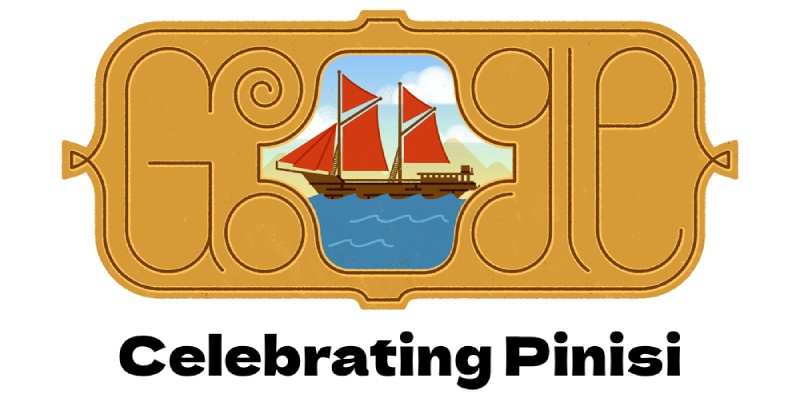Festivals & Events
Interesting Facts about Pinisi, An Ancient Indonesian Sailing Rig

The pinisi, an ancient Indonesian sailing rig that dates back many centuries and was first used on ships in South Sulawesi, is the subject of today’s Google Doodle. Traditionally, an Indonesian sailboat’s gaff-ketch rigging type is referred to as pinisi. It usually refers to the majority of wooden Sulawesi ships built today. Their unique features include a bowsprit and r sails that are distributed over two masts. The term “pinisi” was adopted on December 7, 2017, to represent the skill of boatbuilding in South Sulawesi, which is recognized by UNESCO as an Intangible Cultural Heritage of Humanity.
35 Interesting Facts about Pinisi
- The term “pinisi” literally describes a style of rigging used on Indonesian sailing vessels, which consists of the configuration of masts, sails, and ropes, or “lines.”
- A pinisi has seven or eight sails on two masts that are arranged like a gaff-ketch with what are known as “standing gaffs”; that is to say, in contrast to most Western ships with this type of rig, the two main sails are “pulled out” like curtains along the gaffs that are fixed at the center of the masts.
- As is the case with many Indonesian sailing vessels, the term “pinisi” thus refers only to a particular kind of rig and does not characterize the form of the vessel’s hull.
- The Konjo-speaking people of Ara, a village in the Bontobahari district of Bulukumba Regency, South Sulawesi primarily constructed pinisi-rigged ships. Buginese and Makassarese seafarers used these ships extensively as cargo vessels.
- Today, the majority of Indonesia’s wooden ship types are named with the term “pinisi,” oftentimes rather indiscriminately.
- The term “phinisi,” which was first used to name Phinisi Nusantara, a motorized traditional vessel with a similar rig that was sailed from Indonesia to Expo 86 in Vancouver, Canada, was spelled as “phinisi” in an attempt to mimic the Indonesian pronunciation of the word, /pi:nisi/.
- The 2017 inscription of “The Art of Boatbuilding in South Sulawesi” in UNESCO’s Representative List of the Intangible Cultural Heritage of Humanity featured the phrase “pinisi,” which is the most popular sailing vessel in Indonesia.
- The rig and sail of the renowned “Sulawesi schooner” are examples of pinisi or the Art of Boatbuilding in South Sulawesi.
- The development and use of these boats is part of the millennia-old Austronesian boatbuilding and navigation tradition, which has produced a wide range of highly advanced watercraft.
- Pinisi has come to represent the Archipelago’s native sailing vessels to both the Indonesian and international public.
- Nowadays, Tana Beru, Bira, and Batu Licin are the boatbuilding hubs, employing approximately 70% of the local population in boat construction and navigation jobs.
- A traditional gaff-ketch sailing rig used on ships coming from Sulawesi, the fourth-largest island in Indonesia, is called a “pinisi.” It’s important to remember that in this context, “pinisi” only technically refers to the rigging. Palari boats are typically the vessels to which these rigs are affixed.
- Pinisi boats are distinguished by their large, towering hulls with accommodations at the stern, billowing sails spread over two masts and a bowsprit.
- Pinsi-rigged ships are still in use today for carrying vital goods like rice, sugar, and spices in addition to being used for fishing.
- Compared to the millennia-old tradition of Indonesian boat building, the pinisi boat is a relatively modern invention. The sail design is over a century old, even though it was constructed and launched by hand.
- The term “pinisi” was first used in 1917, but the first pinisi-rigged boat was constructed in 1906.
- With more than 1000 ships in commission, the pinisi design was a commercial success; by the 1970s, it had the largest fleet globally. With the introduction of contemporary shipping, that number has decreased, but Sulawesi still has a thriving pinisi boat design and construction community.
- The largest pinisi boat ever constructed, measuring over 50 meters in length and 500 tons in cargo capacity, was unveiled in south Sulawesi in 2011. The sole significant design change in the last century is the engine, which is installed in most pinisi manufactured after 1980. Nowadays, the majority of pinisi are equipped with a motor as well as sails, allowing the boats to transport cargo upwind if necessary.
- It is only in recent times that the pinisi boat standard or blueprint has been formalized. The knowledge of how to build these ships was passed down orally by boatbuilders in Sulawesi before the 1990s.
- They were initially constructed entirely of local ironwood and without the use of any metal at all. Since “the construction and deployment of such vessels stand in the millennia-long tradition of Austronesian boatbuilding and navigation,” UNESCO has recognized this long-standing tradition and believes it merits a spot on the Representative List of the Intangible Cultural Heritage of Humanity.
- The fact that pinisi boats are now employed in maritime tourism, in addition to trade and fishing, has contributed to the survival of the Sulwesian boatbuilding tradition.
- Pinisi boats are easily transformed into opulent sailing vessels thanks to their large holding capacity, strong rig, and relatively shallow drafts.
- Pinisi boats possess a special capacity to discover every corner of these 17,000 islands, stopping at locations away from the main tourist hotspots.
- Similar crafts, used for several centuries in and around Indonesia, are the source of the “modern” wooden ‘Pinisi’ type. Certain sources declare that dhows like the Arabian Dhow existed before the year 1500.
- Though the ‘Pinisi’ hull type predates those Western hull forms by centuries, the sailing vessel’s hull form resembles a hybrid of two classic American sailing vessel types: the Pinky Schooner and the Tancook Whaler in many aspects. Put another way, the ‘Pinisi’ had a double-ended hull type with a sharply raked stem and stern post in its original configuration. Unlike the American craft, there was no centerline rudder, though. Historically, the indigenous Indonesian vessels were primarily propelled by two rudders, one on each aft quarter.
- The craft we are calling “Pinisi” (also spelled Pinissi, Pinisiq, or Phinisi) are used as cargo and transport vessels. Traditionally, they are built on the beach using logs from Kalimantan (Borneo) and Sulawesi (Celebes) forests, which are then transported to the boat-building sites.
- Building such a vessel has historically involved several fascinating rites and ceremonies, starting with selecting the appropriate trees for important structural elements. Similar to the construction of wooden boats in the West, several customs are followed during the building process to mark the beginning and conclusion of each phase, including the important keel laying.
- Although the first modern pinisi boat was built in 1906 by sailors in South Sulawesi, Indonesian boatbuilding dates back thousands of years. They discovered that removing the central stern post allowed the boats to go faster, a major benefit for moving people and goods. They were inspired by European rigging styles. A massive hull that protrudes over the ship’s bow is a striking feature of its majestic design. Over time, boats have become more and more popular, but Sulawesi still has the most renowned pinisi boat community.
- Pinisi boats started to have engines added in the 1980s. The boat’s design was finally formalized in the 1990s, following years of oral sharing.
- These days, pinisi is mostly used for trade. It is used to carry goods and groceries from industrialized Java to more isolated ports in the Indonesian archipelago or as inter-insular cargo, such as timber from Kalimantan to Java. Pinisi frequently visits traditional ports, including the port of Makassar, Surabaya, Banjarmasin, and Jakarta’s Sunda Kelapa port.
- Pinisi have motors, just like many other traditional ship types; this has been the case mostly since 1970. This has altered the ships’ appearance. Similar to contemporary dhows, the masts have been shortened or removed altogether, and deck cranes have disappeared, leaving only larger deck structures for the crew and passengers, usually aft.
- The world’s largest commercial sailing fleet at the time, thousands of pinisi-palari ships carrying up to 200 tonnes of cargo, had reached every corner of the Indonesian seas in the early 1970s and had become the backbone of the country’s trading:41–42
- Foreign investors frequently convert pinisi into yacht charter boats for tourism. The pinisi boat that served as a pit stop for The Amazing Race is one recent example that can be seen.
- The boatbuilding heritage of South Sulawesi is still being felt today. These days, pinisi boats are the preferred option for tourism and fishing excursions.
- On December 7, 2023, Google featured a Google Doodle on its homepage to celebrate Pinisi.
-

 Business3 weeks ago
Business3 weeks agoPrakash and Kamal Hinduja: Driving Social and Environmental Change
-
Education4 weeks ago
Fred DuVal: University Leadership as a Critical Resource for Climate Change Research and Life-Saving Solutions
-

 Cryptocurrency3 weeks ago
Cryptocurrency3 weeks agoDesigned For The Masses: How Akasha (AK1111) Is Unlocking Crypto For The Next Billion Users
-

 Health3 weeks ago
Health3 weeks agoThe Hinduja Brothers Commitment to Global Health: Empowering Communities Across Borders
-

 Cryptocurrency4 weeks ago
Cryptocurrency4 weeks agoNexaglobal & Future World Token (FWT): Could This Be the Next Big Crypto Investment of 2025?
-

 Startup2 weeks ago
Startup2 weeks agoCost-Saving Strategies Every Small Business Owner Should Know to Boost Efficiency
-

 Startup3 weeks ago
Startup3 weeks agoMatthew Denegre on the Art of Deal Sourcing: Finding the Right Investment Opportunities
-

 Health2 weeks ago
Health2 weeks agoSt. John’s Community Health Examines Innovations in Pharmacy Access























